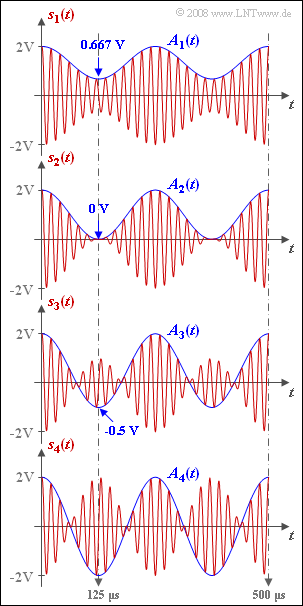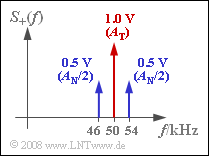Exercise 2.2: Modulation Depth
The graph shows DSB amplitude-modulated signals $s_1(t)$ to $s_4(t)$ with differing modulation depth $m$. Let message signal $q(t)$ and carrier signal $z(t)$ each be cosine:
- $$q(t) = A_{\rm N} \cdot \cos (2 \pi f_{\rm N} t),\hspace{0.2cm} f_{\rm N} = 4\,{\rm kHz}\hspace{0.05cm},$$
- $$ z(t) = \hspace{0.2cm}1 \hspace{0.15cm} \cdot \cos (2 \pi f_{\rm T} t),\hspace{0.2cm} f_{\rm T} = 50\,{\rm kHz}\hspace{0.05cm}.$$
The modulated signal (transmitted signal) with the DC component added in the modulator is $A_{\rm T}$:
- $$s(t ) = A(t) \cdot z(t), \hspace{0.2cm} A(t) = q(t) + A_{\rm T}\hspace{0.05cm}.$$
In the graphs, the chosen normalization was:
- $$A_{\rm T}+ A_{\rm N} = 2\,{\rm V}\hspace{0.05cm}.$$
- If the modulation depth is $m ≤ 1$, then $A(t)= q(t) + A_{\rm T}$ is equal to the envelope $a(t)$.
- In contrast, for a modulation depth $m > 1$:
- $$a(t ) = |A(t)|\hspace{0.05cm}.$$
- The cosine curve $A(t)$ varies between $A_{\rm max}$ and $A_{\rm min}$; because of normalization, $A_{\rm max} = 2 \ \rm V$ is always the case.
- The minimum values of $A(t)$ occur at half the period of the source signal $($i.e., for $t = 125 \ \rm µ s)$ :
- $$A_{\rm min} = q(T_0/2)+ A_{\rm T} = A_{\rm T}-A_{\rm N}.$$
- The numerical values are given in the graph.
Hints:
- This exercise belongs to the chapter Double-Sideband Amplitude Modulation.
- Particular reference is made to the page DSB-AM with carrier.
Questions
Solution
- $$ A_{\rm max} = A_{\rm T}+A_{\rm N}=2\,\,{\rm V},\hspace{0.3cm} A_{\rm min} = A_{\rm T}-A_{\rm N}\hspace{0.05cm}$$
directly follows:
- $$A_{\rm N} = (A_{\rm max} - A_{\rm min})/2,\hspace{0.3cm} A_{\rm T} = (A_{\rm max} + A_{\rm min})/2\hspace{0.05cm}.$$
- Thus, the modulation depth is
- $$m = \frac{A_{\rm max} - A_{\rm min}}{A_{\rm max} + A_{\rm min}}\hspace{0.05cm}.$$
- With the given numerical values, one obtains:
$$ m_1 = \frac{2\,{\rm V} - 0.667\,{\rm V}}{2\,{\rm V} + 0.667\,{\rm V}} \hspace{0.15cm}\underline {= 0.5}\hspace{0.05cm}, \hspace{0.5cm} m_2 = \frac{2\,{\rm V} - 0\,{\rm V}}{2\,{\rm V} + 0\,{\rm V}} \hspace{0.15cm}\underline {= 1.0}\hspace{0.05cm}, \hspace{0.5cm} m_3 = \frac{2\,{\rm V} -(-1\,{\rm V})}{2\,{\rm V} + (-1\,{\rm V})} \hspace{0.15cm}\underline{=3.0}\hspace{0.05cm}.$$
(2) Answers 1 and 3 are correct:
- In this case, $A_{\rm T} = 0$, which means it is indeed "DSB-AM without a carrier".
- The modulation depth $m = A_{\rm N}/A_{\rm T}$ is infinitely large.
(3) The spectrum $S_+(f)$ is composed of three Dirac lines for each modulation depth $m$ with the following weights:
- $A_{\rm T}$ $($at $f = f_{\rm T})$,
- $m/2 · A_{\rm T}$ $($at $f = f_{\rm T} ± f_{\rm N})$.
For $m = 1$, the weights are obtained according to the graph:
- $S_+(f_{\rm T}) = 1\ \rm V$,
- $S_+(f_{\rm T} ± f_{\rm T}) = 0.5\ \rm V$.
(4) The power (root mean square) of a harmonic oscillation with amplitude $A_{\rm T} = 1 \ \rm V$ referenced to the $1 \ Ω$ resistor is:
- $$P_{\rm T} ={A_{\rm T}^2}/{2} = 0.5\,{\rm V}^2 \hspace{0.05cm}.$$
- In the same way, for the powers of the lower and the upper sideband we obtain:
- $$P_{\rm USB} = P_{\rm OSB} =({A_{\rm N}}/{2})^2/2 = 0.125\,{\rm V}^2 \hspace{0.05cm}.$$
- Thus, for $m=1$, the ratio we are looking for is:
- $${P_{\rm T}}/{P_{\rm S}}= \frac{P_{\rm T}}{P_{\rm USB} + P_{\rm T}+ P_{\rm OSB}}= \frac{0.5\,{\rm V}^2}{0.125\,{\rm V}^2 + 0.5\,{\rm V}^2+ 0.125\,{\rm V}^2}= 2/3\hspace{0.15cm}\underline { = 0.667}\hspace{0.05cm}.$$
(5) Using the Dirac weights $m/2 · A_{\rm T}$ of the two sidebands corresponding to subtask (3) , we get:
- $${P_{\rm T}}/{P_{\rm S}}= \frac{A_{\rm T}^2/2}{A_{\rm T}^2/2 + 2 \cdot (m/2)^2 \cdot A_{\rm T}^2/2}= \frac{2}{2 + m^2}\hspace{0.05cm}.$$
- This leads to the numerical values $8/9 = 0.889$ $($for $m = 0.5)$, $2/11 = 0.182$ $($for $m = 3)$ und $0$ $($for $m \to ∞$).
(6) Both statements are true:
- The addition of the carrier only makes sense in order to use the simpler envelope demodulator. This is only possible for $m \le 1$.
- However, should the modulation depth be $m > 1$ and the use of a synchronous demodulator therefore be required, the carrier should be (almost) completely omitted for energy reasons.
- Similarly due to energy concerns, if an envelope demodulator is used, the largest possible modulation depth $m < 1$ ⇒ $m \to 1$ should be aimed for.
- However, a small residual carrier can facilitate carrier recovery, which is needed in a synchronous demodulator for frequency and phase synchronization. Thus, the second statement is only conditionally correct.

